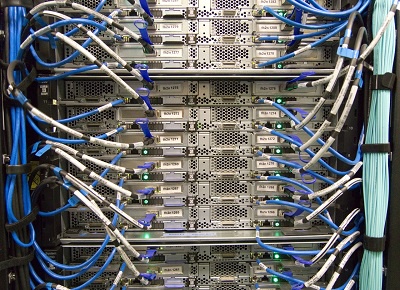A rack server, also known as a rack-mounted server, is a type of computer server. It is designed to fit into a standard 19-inch server rack or cabinet. These servers are generally used in data centers and other high-density computing environments, in which multiple servers are housed in a single location. Their compact and efficient design provides a high level of computing power in a relatively small area. The most common rack server heights are 1U, 2U, and 4U. They are designed for easy access and maintenance, with redundant power supplies and hot-swappable components.
Rack Server: Architecture:
For housing, the server, an enclosure mounting grid (rack) serves as a frame. Inside the rack, server hardware containing server components is mounted either horizontally or vertically. Rack servers can be installed side by side efficiently since they have a standard width of 19 inches and a variety of height units. The installation depth is 60, 80, 100, or 120 centimeters. Some important components of a rack server are the rails guides, brackets for cables, ventilation sensors, and cooling units. Based on safety requirements, the rack servers can also include an extinguishing gas system in an emergency. Other important components of rack servers are:
- CPUs
- Power supply (PSU)
- Random Access Memory (RAM)
- Host bus adapter
- Network cards or adapters
- SSD or HDD
- RAID controller
Advantages Of Rack Server
Some common features of a rack server include:
- High-performance components: Rack servers come with high-performance components, such as multi-core CPUs, ample amounts of RAM, and fast storage options, making them ideal for demanding workloads.
- Compact form factor: These servers are designed in such a manner that they get easily mounted standard 19-inch server racks, making them highly space-efficient.
- Redundant components: To ensure high availability and reliability, rack servers are often equipped with redundant components, such as multiple power supplies and hot-swappable hard drives.
- High density: Rack servers provide great computing power density in a small space, making them excellent for data centers and other high-density computing settings.
- Improved cooling: Rack servers are frequently equipped with effective cooling systems, which help in keeping the servers running smoothly and prevent overheating.
- Scalability: Rack servers are extremely scalable, allowing businesses to rapidly add additional computing capabilities as needed.
- Remote management: Many rack servers provide remote management features, which allow administrators to administer the server from a remote location.
Rack Server Uses
Rack servers are used in a variety of applications, including:
- Data Centers: Rack servers are often used in data centers, where several servers are kept in a single location to offer organizations centralized computing resources.
- Cloud computing: Rack servers are used to construct cloud computing infrastructure, which provides virtualized computer resources to consumers through the internet.
- Enterprise IT: Rack servers are used in enterprise IT environments to host important business applications, databases, and other crucial systems.
- Web hosting: Rack servers can be employed in web hosting environments to host customers' websites and other internet applications.
- Communication: Rack servers handle and control internal and external communication operations.
- File server: Rack servers are frequently used as file servers. They store data and manage network access to storage resources.
- Print server: Server racks are also used in computer networks for dedicated print jobs as well as for routing jobs to printers and plotters.
- Network access server: A network access server is a rack-mount server that manages access to data, programs, or networks.
- Storage: Rack servers can also be used as network-attached storage (NAS) devices, allowing organizations to have centralized storage.
- HPC: Rack servers can be used in high-performance computing (HPC) systems to offer high-performance computing resources for demanding engineering, scientific, and research applications.
- Virtualization: Rack servers are used in virtualization environments, where numerous virtual machines are run on a single physical server to maximize hardware utilization and lower costs.
Rack Server: Disadvantages
- Costly: Rack servers can be more expensive than other types of servers, particularly if they are equipped with high-performance components.
- Complex: Rack servers are more difficult to manage and maintain than other types of servers, particularly in large environments with multiple servers.
- Noise: Rack servers can produce a lot of noise, which can be an issue in quiet environments like home offices.
- Limited upgradability: Some rack servers have limited upgradability options, especially when it comes to components such as memory and storage.
- Power consumption: Rack servers can demand a lot of power, which can raise energy costs.
Conclusion
In conclusion, rack servers provide high-performance computing resources for a wide range of applications in modern computing infrastructure. As a result of their compact size, scalability, and reliability, they are ideally suited for high-density computing environments, such as data centers and enterprise IT environments.


Comments (1)